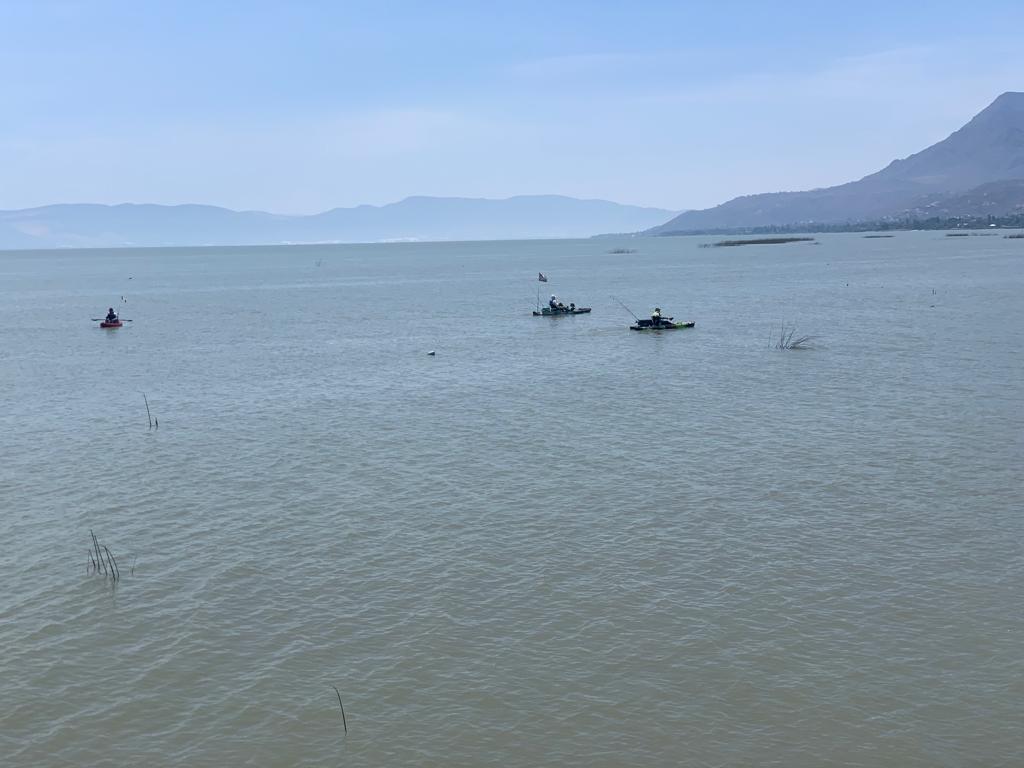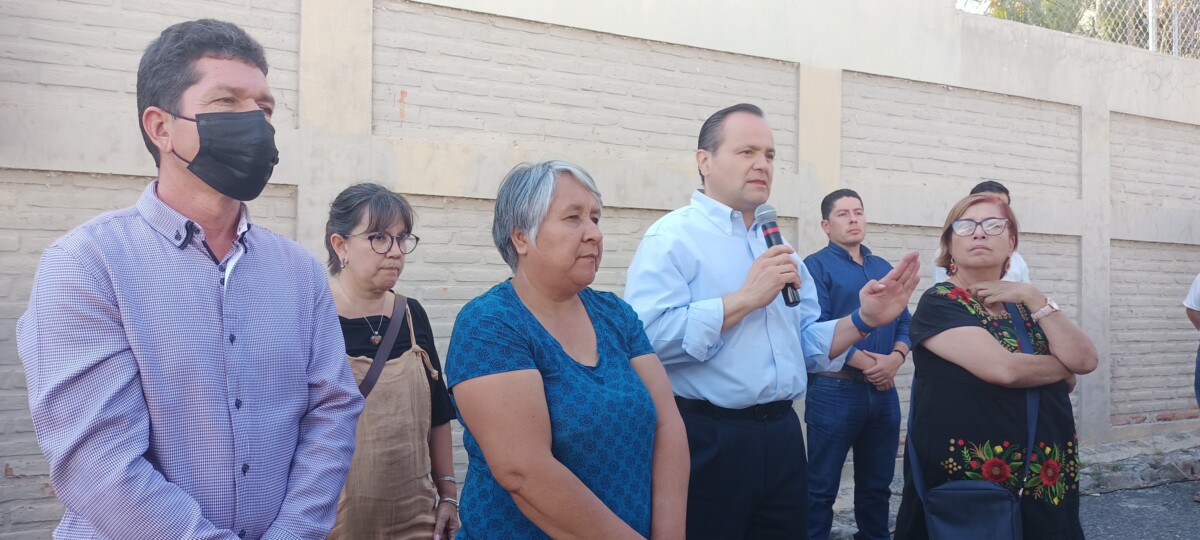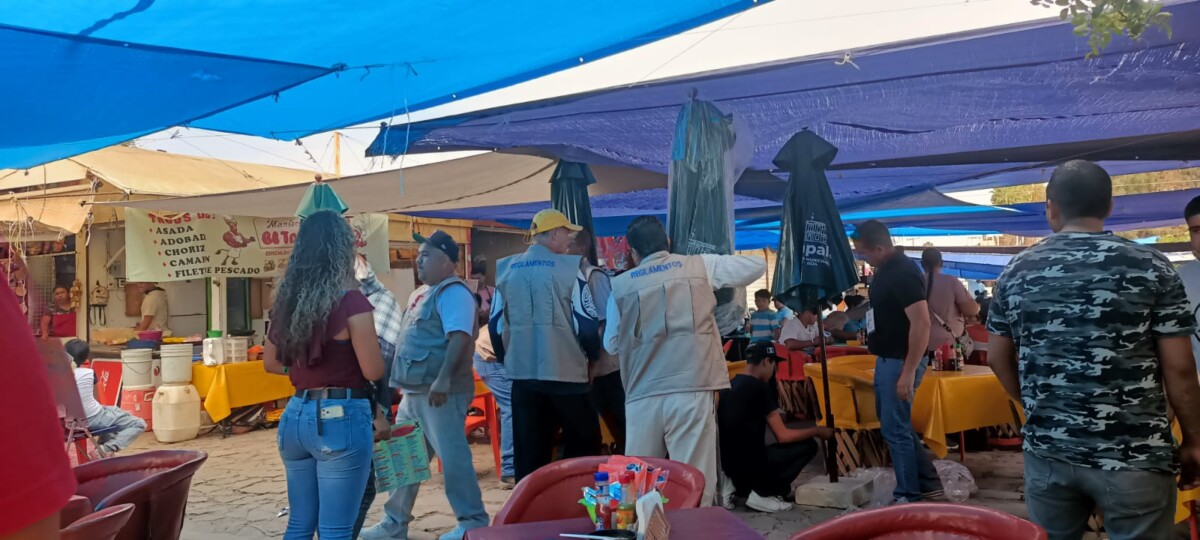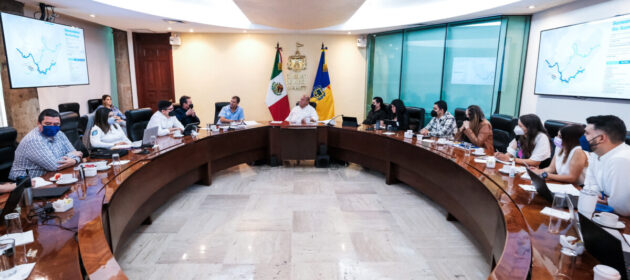ribera
First Earth Day celebration is successful, although participation was lower than expected
Opening ceremony on Friday, April 22. Photo: Sofia Medeles.
Sofía Medeles-Ajijic. The first Earth Day commemoration in Ajijic which took place on April 22, 23 and 24 t was a success although participation was lower than the organizers hoped for. The three-day event consisted of a series of conferences and other activities designed to raise awareness about the need to care for the environment.
Between 150 to 200 people attended each day for a total of 500 and 600 people, mostly adults although there were also interested children.
The first day began with an opening ceremony asking permission to the elements and deities to allow the participants to respectfully carry out the programmed activities. During the closing ceremony on the last day, a tribute and offering was made to Lake Chapala.
The conference speakers included activists who work to safeguard the integrity of both the lake and the mountains, such as Manuel Villagómez Rodríguez, Luis Valdivia Ornelas, Raquel Gutiérrez Nájera and the local resident Julio Carmona. There were also music and film presentations, and tables for information and sale of ecological products.
«I think the event was effective both in the professional and academic quality of the presenters, said Noris Binet, who added that, “ I think it was very ambitious to do it in three days since it demands consistent participation by the public.”
Binet explained that, “ There were three relevant focuses of the event: that battles of this type can and have been won, that Lake Chapala urgently needs to become a Ramsar site, that a mapping of endangered and reserved areas needs to be done that clearly defines where not to buy or build, something the Expats requested I a petition. ( Lake Chapala is listed on the RAMSAR Information Service as RAMSAR as Ramsar Site no. 1973. For its extensive wetlands).
Sihara Casillas Gaeta, another of the organizers, commented that this type of event helps people to learn about the type of land in which they live, about the local aquifers, and to take stock of how corruption has contributed to the deterioration of natural water reservoirs, which helps convince people to be more vigilant.
Jane Custer, who was in charge of translations at the event, said that she was very pleased to see the Mexican and foreign communities of Ajijic together in one place acquiring knowledge to protect the Lake and the environment.
Noris stated that, in the coming years, she believes the event could improve in terms of local participation, involving neighbors and members of indigenous communities, talking about their problems related to environmental issues. She plans to produce an official document summarizing the most important points of the event to be presented to government authorities, as well as the creation of a citizen and academic observatory to monitor and denounce environmental destruction.
Translated by Patrick O’Heffernan
Opinion: Looking at Life in Lakeside
By: Patrick O’Heffernan
Regional Mexican bands and Latin Acts were shot through the program at Coachella Music and Art Festival last week– twenty Latin acts including four regional Mexican bands.
Near the top was Banda MS from nearby Mazatlán, which got the packed crowd moving with their first hit El Mechón», followed by songs like » El Color de Tus Ojos», «Hermosa Experiencia» and bit of «Qué Maldición», originally recorded with Snoop Dog. Much of the crowd seemed to know the lyrics pretty well, at least from the YouTube videos I have watched (I wasn’t there) .
Latin-Grammy winners Groupo Firme from Tijuana energized a screaming crowd of thousands with their hit “El Toxico” on Day 2. Sunday was the Coachella debut of Natanael Cano, who combines rock, rap and pop and corridos, and Ed Maverick from Chihuahuan with his singer-songwriter folk, alternative and rock music mashups.
Other Latin acts included Karol G, Niki Nicole, Anitta, Alaina Castillo, Nathy Peluso, and the Latin-Canadian Jessica Reyes along with American- Mexican bands Chicago Batman, Cuco, Ela Minus, Omar Apollo, Pabllo Vittar, and The Marias .
So why all the Latin acts and four Mexican regional bands at Coachella this year? A few Latino artists have performed at Coachella since its inception in 2001, including Café Tacvba, Julieta Venegas, Nortec Collective and Los Ángeles Azules, but they really broke through in 2019 with the flamenco fusion artist Rosalía, Bad Bunny, and J Balvin in Main Stage prime spots.
The numbers tell us why Mexican and Latin acts were there this year. MRC, which tracks music trends, revealed in its 2021 Year End Report that Latin music album consumption in the U.S. grew by 21.1% in 2021, more than any other core music genre. The number of Latin albums bought and streamed in the US hit 48.2 million and generated more than US$886.1 million, making Latin music the #5 most-consumed music genre NOB.
Latin bands are now for everyone. Whether it’s Bad Bunny, Karol G, Banda MS, or anyone playing reggaeton, research shows the audiences are of mixed cultures. Spanish lyrics are not a deterrent – people love the Latin beats even if they don’t get the lyrics.
Mexican/Spanish music has been around the US since before there was a US, when colonists from Mexico introduced the guitar to Florida and the Southwest of what is now the US. By the 1930’s California radio stations were playing norteño and mariachi for farm workers. Cuban music landed in New York City in the 40’s with Arsenio Rodríguez, Desi Arnez , and La Lupe. During the rock revolution Latinos were there with songs like “La Bomba”, and “Tequila”, and bossa nova.
This year the regional Mexican band Groupo Firme sold out 7 nights at Staples Center in LA, only one night shy of the record set by Adele, a sign that American music audiences – especially younger fans –resonate with Mexican regional sounds.
So the regional Mexican and Latin bands on the program at Coachella last week were following, not leading, the audience. Coachella2022 was another footstep in the progress of music sin fronteras – music without borders. !Viva musica de Mexico!
Pickpockets operating in Lakeside; more than 17 thefts reported
Sofía Medeles- Ajijic. Purse thefts have been reported in at least 17 places in Lakeside in the towns of Ajijic, San Antonio Tlayacapan, the municipal capital of Chapala and San Juan Cosalá,. The thieves have mostly targeted tourists and Expats.
One of the sites of the incidents was the Lake Chapala Society (LCS) in Ajijic, a popular gathering place for both Expats and local Mexicans. LCS executive director Luis Pacheco assured Laguna that the two mishaps were not violent, but rather accomplished by distracting the victims.
«The two thefts occurred in LCS were not violent,. The thieves – a foreign woman and two Latinos – use a practiced modus operandi. There are at least 17 public spaces and restaurants, or businesses, where robberies of this type have occurred and, in some of them, the thieves identified are the same ones who operated here,» said Luis Pacheco.
According to the LCS executive director, the modus operandi of the pickpockets is that the foreign woman approaches to talk to other tourists or Expat residents to distract them, while the other two people create a barrier and grab their possessions.
Pacheco pointed out that the person in charge of Ajijic’s office, Maximiano Macías Arceo, Chapala Security Commissioner Sergio Conzuelo Ramírez, and the municipal president, Alejandro Aguirre Curiel, are aware of the events, so they are working together to create a crime prevention campaign in the area.
This was confirmed by Macías Arceo who said that this campaign would be focused on training restaurant owners, administrators, block chiefs, etc., in the prevention of crime, and that, although there is still no date to start, it will be announced through the department of Social Communication.
Luis Pacheco said that the most important to reduce crimes is to reestablish the social fabric where neighbors will have co-responsibility and support each other to take care of themselves and educate themselves about this type of crime.
Translated by Patrick O’Heffernan
Muere ahogado en el lago de Chapala
El occiso sufrió una volcadura en el kayak mientras navegaba en el lago de Chapala. Foto: cortesía.
Redacción.-Un habitante en San Antonio Tlayacapan sufrió un accidente luego de volcar su embarcación, perdiendo la vida por sumersión en el Lago de Chapala.
El ahora occsiso es una persona de una familia conocida en San Antonio Tlayacapan: el ahora occiso, fue localizado sin vida 15 minutos después de la volcadura del kayak, a las 2:15 pm de acuerdo al reporte de las autoridades.
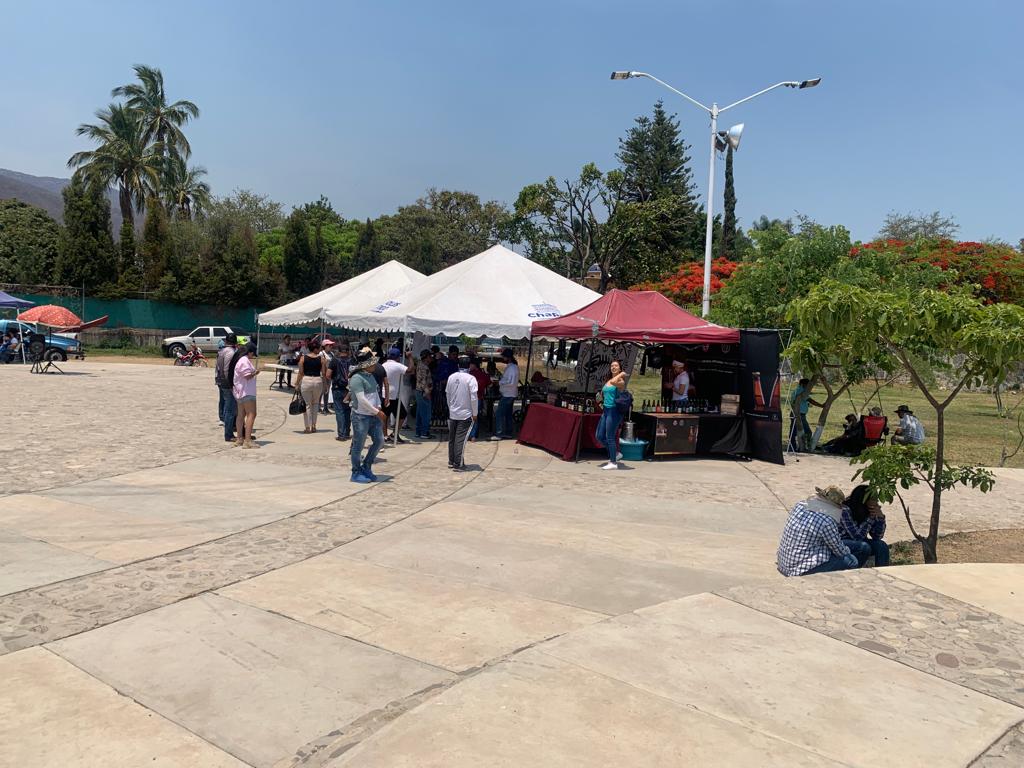
Federico Aguayo fue localizado sin vida 15 minutos después de la volcadura del kayak. Foto: cortesía.
Looking at Life in Lakeside
By: Patrick O’Heffernan
I am so looking forward to this weekend’s celebration of the Passion of Christ. Although my wife and I bought our house in Ajijic over 5 years ago, we actually did not move in until almost 3 years ago. The preceding years we visited, managed a ranch, and stayed in various homes around Lakeside. We were never here during Semana Santa and Easter, so this will be my first. I experienced Christmas in Baja when I was in my 20’s, but I understand the two holidays and the attendant celebrations are nothing alike.
I am going to find out, for sure. The route of the Passion of Christ goes right by my house. My neighbors and I will be in a mirador that overlooks the pathway up to the Stations of the Cross in the tépalo, and the return procession will go down our street. Dale Hoyt Palfrey of the Guadalajara Reporter published an excellent photo essay of the Passion, from past years from the trial and flogging all the way up the mountain to the crucifixion; going through her photos made me realize the scale of the event.
I am not a Catholic, although my mother insisted I go to the local Catholic grammar school (supposedly “better” than the public school), so I am familiar with the story. But the focus was always on Easter, with Good Friday and Palm Sunday distant seconds. We did the stations of the Cross on Good Friday in the church attached to the school, but that was it. The idea of the entire story being reenacted with full costumes, supporting casts and a crucifixion is a mind-boggling reminder of the power of religion.
In retrospect, it shouldn’t be. In Indonesia I watched the procession of the Hindu festival Thaipusam where thousands of devotees followed long lines of entranced men and women who pierced their cheeks with spears and put hooks through their skin attached to ropes dragging weights behind them So, following an actor playing Christ carrying a cross up the trail through the hills is not surprising, but the scale of the event here in Lakeside is impressive.
I was always taught to respect people’s practice of their religion, as long as it did not harm anyone (apparently the people in Thaipusam felt no pain while in a trance and healed very quickly). I understand that the Passion may involve hardship and maybe pain for some of the actors, but that is their passion and it is to be respected, as is the whole celebration and the devotion of the people in it and following it, Expats and Mexicans.
Which makes me think a little about Santa Semana and tourism. I was out on the streets today in downtown Ajijic and they were very crowded. People were shopping, cruising the sidewalks with takeaway margaritas and beers, enjoying themselves, as they should be.
But various government officials in Lakeside’s municipalities have predicted as many as 2 million visitors will arrive in Chapala and 180,000 in Jocotepec. Seems high to me – that would be 25% of the population of Guadalajara arriving and spreading out through the towns of Chapala. In Jocotepec, that would be an increase in population greater than all of Lakeside. But that is what they said, so we reported it. And we will report on the actual numbers, if they are calculated.
While numbers like that may be good for business – assuming everyone can actually get here and find a place to park and a restaurant table – I worry that the sheer numbers of people on holiday may not encourage respect for the Passion. If you are here on a holiday weekend, you are having fun, and there is probably no way you are going to be one of the 2,000 people following the procession up to the crucifixion, so you might be tempted to ignore the solemn event taking place. But, like I said, this will be my first Good Friday celebration in Ajijic and I may be pleasantly surprised by the respect of the crowds. I hope so.
Chapala’s City Hall presents major water treatment and drainage project for Riberas del Pilar
Chapala Municipal president, Alejandro de Jesús Aguirre Curiel, with microphone in hand, the municipal agent Ana María Huerta Rivera, the councilman of Riberas del Pilar, Jesús González Amezcua, and two of the members of the new neighborhood committees.
Jazmín Stengel (Chapala).– The Chapala City Council presented a project for the installation of a sewage system to benefit the population of the Riberas del Pilar. The work is estimated to cost 68 million pesos, to be paid in equal parts by the municipal government and by residents. The Council claims that the properties that currently have private septic systems are contaminating the environment and the project is needed.
After introducing Ana María Huerta Rivera as agent for Riberas del Pilar, and asking the residents to watch for increasing shoreline invasions of federal zones, President Alejandro de Jesús Aguirre Curiel, presented the details of the project.
«This is a proposal, which consists of installing much-needed drainage. It also includes a water treatment plant. We have to do this together, the municipal government and each one of the taxpayers.» He added that the proposal has been reviewed for feasibility.
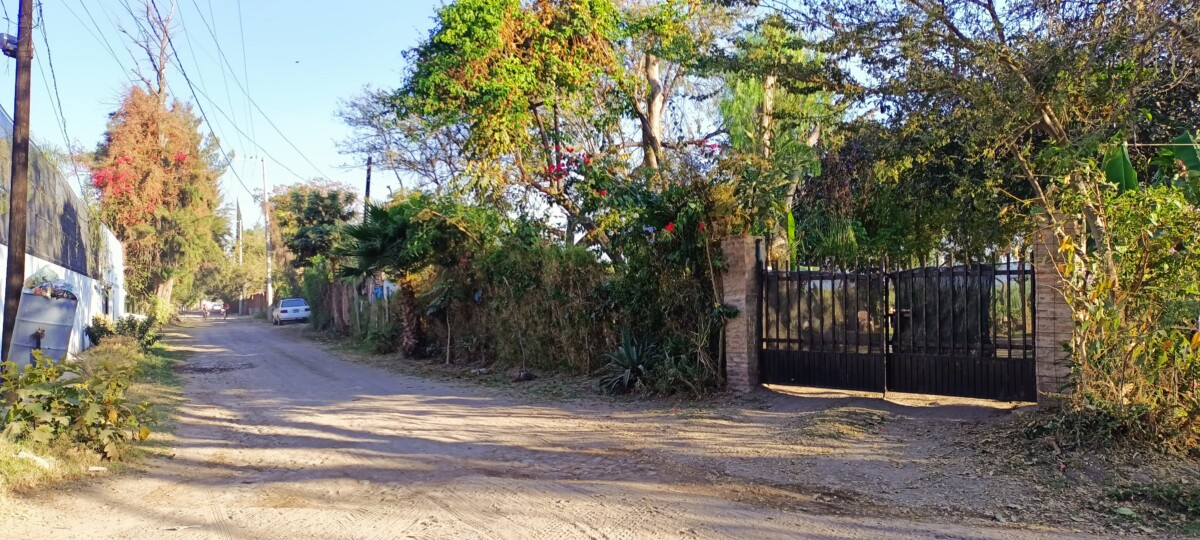
The plant would be built on Paseo del Lago street, on the corner of San Mateo towards San Lucas street, in the Riberas del Pilar municipal agency. Credit: Jazmín Stengel.
The project, presented on April 5, includes drainage lines, a modular treatment plant which would be located between San Lucas and San Mateo streets on the shores of the lake, and the connector. It would be built out in one single six-month stage.
The current municipal administration asked residents to agree to the 50/50 cost split. Cost-sharing is necessary as there is not any available support from federal or state programs. In addition, officials said that they need 25% of the total cost of the project in advance to start the work. Residents have about 45 days to contribute the first 17 million pesos. If the funds are not raised, they will be returned to those who have contributed. The deadline was established by the approximately fifty residents present at the meeting. Government representatives assured that they had 34 million pesos available for the project.
In order to collect the remaining 34 million pesos from Riberas del Pilar residents, each homeowner will be charged 70 pesos per square meter of land, business owners will be charged 100 pesos per square meter. Riberas del Pilar covers 237 hectares, and contains about registered 1,500 properties.

Fernando Antonio Monreal Mendoza, engineer in charge of the work and director of the Municipal Potable Water and Sewage System (SIMAPA).
There will be two ways to quote the fee and make the corresponding payment. The first is bring your property deed Municipal Water and Sewage System (SIMAPA) office, located in the new administrative unit located 62 Hidalgo Avenue. The second option is to wait for the formation of one of four neighborhood committees that are expected to be formed.
Connections from the houses to the public sewage system are not included in the cost of the project, or in the fees collected. Homeowners and business owners will be responsible for their own costs to connect to the system. Current estimates are 14,000 – 18,000 pesos per house. Officials said that anyone who does not pay the required fees for the project will not have the right to connect to the public drainage, and will be fined in the future for environmental contamination.
Present for a short time during the meeting were the municipal president Alejandro de Jesús Aguirre Curiel, the director of the Municipal Potable Water and Sewage System (SIMAPA) Fernando Antonio Monreal Mendoza, Juan Carlos Pelayo, advisor to the City Council, as well as council members, and the recently-appointed delegado, Ana María Huerta Rivera.
Translated by Amy Esperanto
Columna: Salud y bienestar en la Ribera
Por Leticia Trejo:
Estoy reacomodando mis libros, es impresionante la cantidad de libros que llega uno a acumular con los años. Mis favoritos, claro, son los que hablan de la Salud y el Bienestar y encontré uno que habla de la relajación, su primera edición fue en 1973 y lo escribió Marianne Kohler. ¡Han pasado más de 40 años! Y todavía no hemos logrado que la cultura del buen descanso, la relajación y el reposo penetren en nuestras sociedades, en nuestras culturas ni en nuestras células. Me parece muy relevante que la autora mencione que el descanso es importante para el dominio de sí mismo. Generalmente nos metemos en problemas, porque ante un estímulo que nos incomoda reaccionamos en lugar de responder.
Tuve un maestro de meditación que nos explicaba que cuando se logra el autodominio somos capaces de vivir el estímulo, ver el pensamiento consecuente, sentir la emoción inevitable, pero con el entrenamiento adecuado tenemos la capacidad de hacer una pausa y eso, queridos lectores, hace la diferencia entre una reacción y una respuesta. Una reacción es primitiva, generalmente irracional y va cargada de adrenalina, es veloz y si le pusiéramos un color sería roja, como la señal de peligro. Una respuesta es racional, en milésimas de segundo, pasa por un análisis en el que conscientemente se toma la decisión de cuál es la mejor forma de actuar ante ese estímulo y si tuviera color sería quizás verde como la señal de adelante. Puedo confesar ahora que, el motivo por el cual hace 22 años cambié mi vida fitness de gimnasio, spinning y música electrónica por el estudio, la práctica y la enseñanza del Yoga, es porque estaba harta de reaccionar ante cualquier estímulo, siempre sintiendo que los demás me hacían cosas de las que debía defenderme o atacar, como en estado de alerta. No es de extrañar que este libro, al final, también hable de Yoga.
Para reposar y descansar no necesitamos grandes inversiones ni de tiempo ni de dinero, solo una revisión honesta de qué tanto estamos apegados a nuestro amado estrés; sí, así es, hemos tatuado en nuestro ADN la tensión crónica, el encogimiento muscular, el endurecimiento de los tejidos conectivos, de modo que el día que intentamos bajar la velocidad y el ritmo llegamos a sentir ansiedad y la mente dando su opinión dice que “eso de relajarse no sirve para nada, que no estamos para perder el tiempo en tonterías, mejor sigamos estresándonos que eso nos sale tan bien”. Aprender a relajarse es aprender el arte de preservar el mayor tiempo posible la juventud en la mente y en el cuerpo. Quiero ser honesta contigo, al principio odiarás intentar relajarte, te dará ansiedad o te sentirás muy, pero muy incómodo, pero si continúas y sabes ser paciente los beneficios son ENORMES.
Mejora la calidad de tu piel, duermes mejor y te despiertas descansado, la energía te dura más, tu mente está más clara y enfocada, tu digestión mejora y no estarás cansado todo el día. Hay dos pautas vitales para lograrlo: aprender a estirarse y aprender a respirar. Si queremos prevenir el cansancio crónico debemos divertirnos sanamente, la fatiga nace generalmente del aburrimiento.
Estírate, visita a algún amigo o amigos, haz ejercicio físico, respira conscientemente, practica mindfulness, practica meditación, y hazte consciente de que cuando tu logras el equilibrio entre estrés y reposo estás mejorando tu calidad de vida y tus relaciones con los demás.
Pese a protestas de comerciantes del malecón, Ayuntamiento de Chapala hará valer la reglamentación establecida
Personal de Reglamentos Chapala regresó al malecón con las sombrillas verdes para colocarlas en la zona de comida del malećon. Foto: Jazmín Stengel.
Redacción (Chapala).- Pese al cierre de las principales vialidades en la cabecera municipal de Chapala, por parte de comerciantes que se han negado a cooperar con el plan de nueva imagen urbana en el malecón propuesto por las autoridades, el Ayuntamiento hará valer la reglamentación establecida para la mejora de la imagen urbana del municipio.
Y es que, después de la manifestación, el personal de Reglamentos Chapala regresó al malecón a colocar las sombrillas verdes. La resolución de este conflicto, según el director de Reglamentos, es que las sombrillas serán colocadas antes de retirar las lonas para no molestar a los turistas.
En un comunicado de prensa, el ayuntamiento manifestó que “no será impositor ni opresor, respetará los derechos adquiridos legalmente por parte de los comerciantes pero también será garante de las leyes, reglamento municipal y derecho de libre tránsito de las personas”.
Las lonas que fueron retiradas y que según autoridades dan mala imagen a la zona de comedores del malecón fueron colocadas nuevamente por los comerciantes inconformes que se niegan al uso de sombrillas, ya que dicen son de mala calidad y no cuentan con recursos para pagarlas. Horas más tarde la autoridad se impuso e hizo el retiro de las lonas.
El retiro de las lonas fue lo que provocó que decenas de comerciantes cerrarán varias vialidades de la cabecera municipal de Chapala, la tarde de este 14 de abril, argumentando que se las autoridades les quieren imponer el uso de sombrillas y además cobrarselas a 2 mil 800 pesos.
Sin embargo, el Ayuntamiento desmintió dicha versión, informando que la compra de las sombrillas las pueden realizar los comerciantes donde mejor les parezca, no obstante, el gobierno municipal está ofreciendo sombrillas a 2 mil 800 pesos, ya que será obligatorio el uso de éstas en la zona restaurantera del malećon con el fin de evitar las lonas de plástico. El último acuerdo es presentarselas, informó Comunicación Social. .
Las autoridades también aclararon que no todos los comerciantes de la zona de comida del malecón están inconformes, pues ocho de 16 que venden en la zona sí acataron la medida de mejorar la imagen urbana.
Te compartimos el texto del comunicado oficial del Ayuntamiento de Chapala:
Por lo que las lonas colocadas para dar sombra a la área de comida en el malecón de Chapala
Gobierno de Chapala trabaja por mejora de imagen urbana en malecón en diálogo constante con comerciantes
El Gobierno Municipal de Chapala informa en relación a los bloqueos viales registrados el día de hoy por comerciantes del malecón lo siguiente:
El Gobierno Municipal como parte de un ordenamiento del área del malecón y mejora de la imagen urbana del área y espacio público que naturalmente es el Malecón ha venido trabajando por etapas un proceso de cambios para beneficio de todas y todos, con el objetivo de tener espacios limpios, dignos, salubres y de calidad para habitantes y visitantes de Chapala.
◦ Hoy como parte de un operativo de vigilancia y regularización por parte de la Dirección de Reglamentos del Municipio, se realizó una visita a los comerciantes del malecón con el fin de revisar el cumplimiento de la reglamentación de la nueva imagen urbana previamente notificada.
◦ Durante el recorrido y se pudo constatar que algunos establecimientos incumpliendo, al tener colocadas lonas y toldos. Por lo que se les pidió retirarlas y se le recordó que el único mobiliario permitido para los comercios con previo permiso de venta de alimentos; dentro del proyecto de mejora de imagen urbana, son sombrillas de color verde con base de cemento.
◦ Dicho oficio fue entregado por parte de la Dirección de Reglamentos bajo el siguiente texto:
Por este medio el cual aprovechamos para saludarlos, nos permitimos notificarles que con el propósito de dar un mejor servicio y mejor imagen al turista y a los visitantes de Chapala especialmente al área del malecón, a partir del día 13 abril del año en curso, queda prohibido el uso de lonas, mantas o toldos en las áreas de venta de comida y bebidas.
Únicamente se podrá utilizar las sombrillas autorizadas en las áreas mencionadas.
◦ Las sombrillas autorizadas deben contar con la siguientes especificaciones:
– Ser de color verde.
– Tener base de concreto.
◦ Es muy importante puntualizar que el Gobierno Municipal ofreció a los comerciantes un contrato de donación oneroso por el 50% del costo de sombrillas que cumplen con las especificaciones anteriores, por la cantidad de 2,800.00 (dos mil ochocientos pesos) a crédito y que serán destinados para beneficiar tareas y actividades del DIF Municipal.
◦ El Gobierno Municipal de ninguna manera vende o impone la compra de las sombrillas a los comerciantes, solo se informa que se hará valer la reglamentación establecida para la mejora de la imagen urbana del municipio y que los habitantes y visitantes tengan espacios dignos, limpios y de calidad, para disfrutar del atractivo turístico que representa Chapala y su lago.
◦ Cabe destacar que el proyecto de cambio de imagen urbana se ha socializado y dialogado desde hace 8 semanas atrás; el Gobierno Municipal no será impositor ni opresor, respetará los derechos adquiridos legalmente por parte de los comerciantes pero también será garante de las leyes,reglamento municipal y derecho de libre tránsito de las personas.
Alistan nieves de garrafa para recibir a los turista
Jhonathan Chávez preparando un tejuino, una de las bebidas predilectas para los turistas durante la temporada. Foto: Héctor Ruiz.
Héctor Ruiz Mejía.- Tradicionales y artesanales nieves de garrafa, junto con el tejuino, se preparan para recibir a los turistas que pasarán la Semana Santa en Jocotepec.
Estos productos, que destacan por su frescura en la temporada de calor, son algunos de los más buscados por los visitantes, tanto en las cercanías de la plaza principal como en el malecón.
Las Nieves de Garrafa “Chávez”, atendido por Jhonatan y su padre, es uno de los puestos más solicitados por estar ubicado a un costado del templo del Señor de Monte, por la calle Miguel Arana, en el primer cuadro de la población.
Por más de 30 años esta familia ha perfeccionado la receta de la nieve de garrafa, ofertando más de 20 diferentes sabores de lunes a domingo de diez de la mañana a seis de la tarde.
En este puesto, los sabores más pedidos son: chongos zamoranos, zarzamora con Philadelphia, Ferrero Rocher, queso crema y pétalos de rosa, sin olvidar los tradicionales sabores como vainilla, chocolate, limón y coco.
“Antes de llegar aquí a Jocotepec, había escuchado de su tradicional nieve de garrafa, pero hasta que la probé, supe de qué hablaban, me encanta venir a la plaza por mi nieve de chongos zamoranos”, comentó Alice, quien lleva más de 20 años viviendo en el municipio.
Por último, el tejuino no se queda atrás, la deliciosa bebida elaborada a base de maíz fermentado, piloncillo y limón, es una experiencia imperdible, además de que contiene probióticos, microorganismos que ayudan al buen funcionamiento del sistema digestivo.
Según estimaciones de la dirección de Turismo y Fomento Artesanal de Jocotepec, se espera que durante la Semana Santa y de Pascua visiten el municipio cerca de 18 mil personas.
Enrique Alfaro presentará en mayo avances de saneamiento del Río Santiago
Este 11 de abril, el ejecutivo estatal mantuvo una reunión para revisar los avances del programa de saneamiento del Río Santiago. Foto: Gobierno de Jalisco.
Redacción.- A mediados del mes de mayo del presente año, el Gobierno de Jalisco presentará un corte de caja de las acciones realizadas los primeros tres años de esta administración sobre la estrategia de recuperación integral del Río Santiago, adelantó el Gobernador Enrique Alfaro.
El balance que hará el Ejecutivo, dijo el Gobernador de Jalisco, incluye también los trabajos que se hacen para atender los problemas de salud relacionados con la contaminación en poblaciones aledañas a los ríos Zula y Santiago, lo que falta por hacer y las obras urgentes que se requieren en este tema, las cuales costarán alrededor de cuatro mil mdp.
“Se hará una evaluación integral de todo el plan para el saneamiento del Río Santiago con la presencia del equipo que está trabajando en el frente de derechos humanos para atender la recomendación que hizo la Comisión Interamericana de Derechos Humanos sobre este tema, está el área de medio ambiente, de protección, la Proepa, la Secretaría de Gestión Integral del Agua, Gestión del Territorio, están las áreas que están trabajando en los temas sociales que es una de las apuestas importantes para este año en las comunidades más afectadas por la contaminación del Río Zula y Río Santiago, estamos trabajando con los temas de salud y haciendo una valoración integral de cómo vamos a tres años de haber arrancado una estrategia muy compleja en la que hemos invertido miles de millones de pesos, en los que hay avances importantes en los frentes que nos pusimos como prioridad de atención pero también desafíos enormes”, dijo Alfaro.
Agregó que, como parte del ejercicio de rendición de cuentas a desarrollarse entre la segunda o tercera semana de mayo, también se contempla hacer un Plan de Desarrollo de largo alcance donde pueda darse una participación ciudadana efectiva.
“Hay desafíos enormes, particularmente en términos presupuestales, estamos hablando de la necesidad de financiar obras de urgencia por alrededor de cuatro mil mdp; también estamos trabajando en un ejercicio de planeación y de prospectiva para poder a mediados de mayo hacer un balance de cómo vamos, de cómo está la calidad del agua, como estamos midiendo los resultados de las intervenciones que hacemos y plantear un Plan de Desarrollo de largo alcance que pueda tener una participación ciudadana efectiva, que pueda ser objeto de un ejercicio de diálogo y de discusión pública que vamos a desarrollar en los próximos meses”, destacó el Gobernador.
Finalmente, el titular del Poder Ejecutivo se dijo satisfecho del esfuerzo que ha hecho el Gobierno de Jalisco en el primer trienio, pero consciente del enorme esfuerzo que se requiere para concluir los proyectos y acciones establecidos en este gobierno.
© 2016. Todos los derechos reservados. Semanario de la Ribera de Chapala



